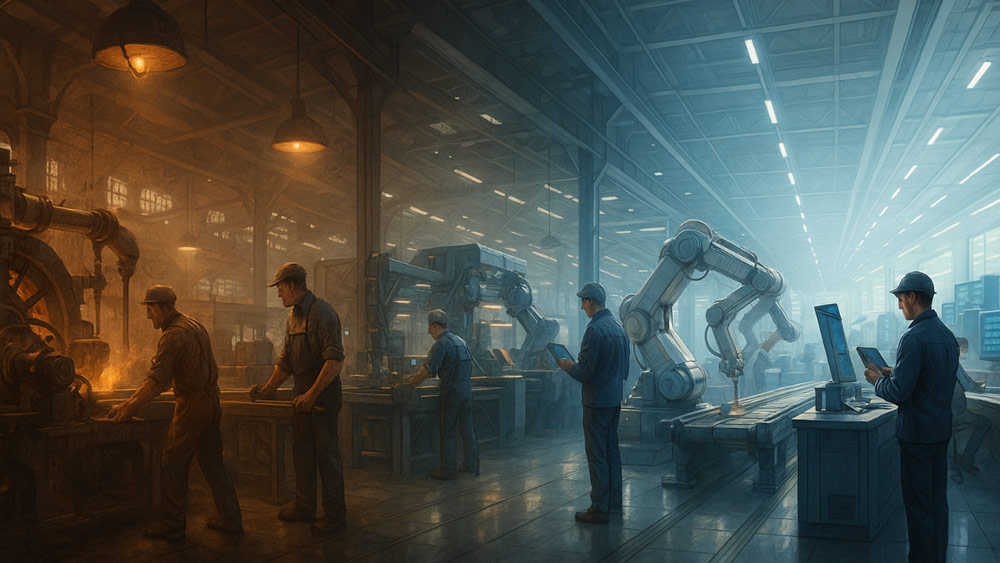
By Dr. Wael Ibrahim, ECPI University’s Dean of the School of Engineering Technology
Over the last few centuries, manufacturing has undergone several major revolutions, from Industry 1.0 to Industry 4.0, with Industry 5.0 now forthcoming. Each revolution marked a leap in technology. We moved from manual assembly to the steam engine, then from the assembly line to advanced manufacturing systems and robotics. Today, we’re entering the age of artificial intelligence (AI).
Industry 4.0, the digital revolution, focused on increasing productivity through automation, robotics, and machine learning. Industry 5.0, the smart, human-centric revolution, builds on this foundation by creating more sustainable and resilient industrial systems.
Each industrial revolution has brought its own challenges and opportunities. However, one thing remains constant: manufacturing continues to play a vital role in improving and advancing our lives. It influences everything from the everyday gadgets we use to the military technologies that keep us safe.
Through all these changes, manufacturing jobs and the skills required to perform them have continued to evolve. This evolution has not eliminated jobs but rather redefined them. As a result, leading industries are strengthening their existing workforce through reskilling and upskilling efforts, while expanding their talent pool to satisfy new demands.
The Post-Pandemic Manufacturing Landscape
During the COVID-19 pandemic, the U.S. manufacturing sector was put to the test, revealing a heavy dependence on offshore components for production. The disruption in the supply chain rippled through the manufacturing sector and ultimately reached us, the consumers. This impacted everything from toilet paper to integrated circuits (ICs).
Manufacturing employment has now surpassed pre-pandemic levels, and the number of manufacturing establishments has increased by more than 11% between 2019 and 2023. Additionally, federal incentives such as the CHIPS Act, the Inflation Reduction Act, and the Infrastructure Investment and Jobs Act have stimulated capital investment and facility expansion.
Despite such promising post-pandemic growth, the manufacturing sector still faces a major hurdle: a significant labor shortage driven in part by the skills gap.
Facing the Challenges of Industry 5.0
It is projected that between 2024 and 2033, the U.S. manufacturing sector may need 3.8 million new employees. Yet, the National Association of Manufacturers (NAM) warns that as many as 2.1 million manufacturing jobs could go unfilled by 2030 due to insufficient qualified talent and a growing skills gap.
One reason for this labor shortage is the aging workforce. With an average age of 43 among engineers, many experienced workers are retiring and leaving the industry. However, there is great difficulty in finding new talent to take their place. This challenge is further compounded by the outdated perception of manufacturing as blue-collar work and the misperception between industry needs and academic preparation.
This raises an important question for us as educators: should we prepare our students for the jobs of today or the jobs of tomorrow?
Bridging the Skills Gap through Workforce Development
Bridging the skills gap is one of the most pressing issues in modern manufacturing. As the demand for new skills grows, industry and academia are rethinking how to respond. Success will depend on both individual and collaborative efforts.
Retraining the Modern Manufacturing Engineer for AI and Automation
As the labor force shrinks, industrial leaders are turning to automation and AI in manufacturing. Just as engineering graduates must keep pace with innovation, manufacturers must ensure that their existing workforce evolves to adapt to this shift. This means training, reskilling, and upskilling employees to give them the skills needed to manage and repair new AI-driven automated systems.
This shift to automation doesn’t mean engineers are simply being replaced by AI, however. Jobs are being redefined rather than eliminated.
While AI plays a critical role in engineering applications, it will not be able to replace the senses that an engineer possesses. Working in an industrial facility, engineers rely on more than programming software and simulation. They also use their sight, hearing, smell, and touch to fully assess situations. This is something AI cannot replicate.
AI is ultimately just another tool in the toolbox that engineers add to over years of experience on the job.
Preparing the Modern Engineering Graduate for Industry 5.0
Historically, academia has been very adaptive to industry needs. Programs such as mechatronics and systems engineering were created in response to changing demands. Likewise, engineering technology curricula are informed by applications of robotics, machine learning, and the Internet of Things (IoT). Now, we are seeing major technological breakthroughs in AI and machine learning.
The rapid change in the manufacturing landscape necessitates that graduates be ready for more than just Industry 4.0. They must also be capable of adapting to Industry 5.0, where human innovation and creativity are key.
Today’s engineering technology graduates must be versatile. The pace of innovation requires fluency in a wide range of areas, including prompt engineering, simulation, validation, cyber-physical systems, and AI application.
Building Collaboration Between Industry and Academia
To adequately prepare students, we must also address the disconnect between industry and academia. This can begin by encouraging meaningful collaboration.
Collaboration between industry and academia can take many forms. One way is through hosting regular industrial advisory boards meetings. This gives educators insight into the present and future needs of industries, which can then shape their curricula.
Other means include offering more opportunities for practical training, including internships or sponsorship of senior projects. These opportunities allow students to apply their knowledge in real-world environments.
Institutions can also incorporate apprenticeship and micro-credentials programs. In fact, accrediting bodies such as ABET are now offering recognition of micro-credentials.
Through these partnerships and programs, we can ensure career readiness for students right out of the gate.
What Does the Factory of the Future Look Like?
The future of manufacturing is built on the principles of Industry 5.0, where people and technology work together. New advanced technologies like Siemens Xcelerator and NVIDIA’s Isaac Sim give us a preview of the AI-powered factories of tomorrow. They allow developers to test and train AI robots to perform complex jobs in simulated virtual environments that mirror the real workplace.
To survive in this landscape, we must adapt to it. As human beings, we must recognize our roles and responsibilities in this AI age. And as educators, we must ensure our students are prepared to do the same.
That is why ECPI University is launching the Master of Science in Engineering Technology (MSET) program next spring. The program will feature at least two advanced robotic environments, giving students the opportunity to apply theory, simulate industrial processes, and explore how automation, AI, and human collaboration intersect.
If we fail to adapt to Industry 5.0 now, we will risk being left behind when Industry 6.0 inevitably arrives.
About the Author: Dr. Wael Ibrahim
Dr. Wael Ibrahim is the Dean of the School of Engineering Technology at ECPI University. Drawing on more than thirty years of experience in higher education, Dr. Ibrahim is dedicated to developing career-focused, experiential learning programs that connect classroom instruction to real-world engineering and technology applications. His leadership continues to shape ECPI University’s commitment to preparing graduates for success in a fast-changing, technology-driven workforce.

